Missouri Department of Conservation Seeking Elusive Answers About Ruffed Grouse
OutdoorHub 10.18.11

Jefferson City, MO – Jason Isabelle wants to know if the ruffed grouse has a future in Missouri. The Quail and Upland Wildlife Federation (QUWF) wants to help Isabelle answer that question, and other states are watching.
Isabelle’s duties as a resource scientist for the Missouri Department of Conservation (MDC) include studying ruffed grouse, handsome, forest-dwelling birds three or four times the size of a bobwhite quail. He inherited the duty from a line of biologists going back to the early 1940s, when MDC launched its first grouse-restoration effort.
Those efforts, which ended in the mid-1990s, transplanted more than 4,000 grouse from other Midwestern states to the best available habitat in Missouri. Most of the birds went to the central Ozarks, north-central and east-central Missouri.
Ruffed grouse persist in very small numbers in a few of the original restoration areas, including an area known as the River Hills Conservation Opportunity Area in Callaway, Montgomery and Warren counties. However, grouse numbers have dwindled to the point where the Conservation Commission closed the ruffed-grouse hunting season last year based on a recommendation from MDC biologists. The most likely cause of their decline is inadequate habitat.
“Ruffed grouse need a mosaic of old and young forests to prosper,” said Isabelle. “They need areas where timber harvests or storms have removed or killed all the trees, creating early-successional forest habitat. They just can’t survive without scattered areas of disturbance in a larger forest setting. Over the course of the last several decades, the amount of young forest habitat has declined substantially throughout the southern portion of the ruffed grouse’s range.”
That accounts for the relative abundance of grouse that existed in Missouri in the early 1800s. Although Missouri is at the southwestern edge of the species’ natural range, early settlers cut down trees for fuel and building material, creating a patchwork of clear cuts, young forest and mature timber that was made to order for ruffed grouse. Missouri’s grouse boom was short-lived, however. It went bust from a one-two punch of relentless market hunting and large-scale logging that denuded vast areas of Missouri’s timberlands.
Conservationists are optimists by nature, so when QUWF approached MDC about giving ruffed-grouse restoration another try, Isabelle set aside earlier discouragements and considered the possibilities.
“Over the past decade, there has been an ongoing effort to increase the amount of early-successional forest habitat in the River Hills region of east-central Missouri,” said Isabelle. “This effort has involved a number of partners conducting habitat work on both public and private lands.”
Working cooperatively with the Missouri Resource Assessment Partnership and the USDA Forest Service, MDC plans to conduct a systematic evaluation of potential grouse habitat within the River Hills Conservation Opportunity Area. With that information, said Isabelle, MDC will be in a position to decide whether another attempt at grouse restoration makes sense.
Missouri is not the only state examining its ruffed-grouse management options. Other states on the southern edge of the ruffed grouse’s range have documented declines similar to the one seen here. Isabelle said other states in the southern portion of grouse range will be watching closely to see what comes of studies in the Show-Me State.
Goals of Missouri’s ruffed-grouse studies will include determining:
- The quality and quantity of available habitat in the River Hills Conservation Opportunity Area.
- The likelihood of establishing a self-sustaining grouse population.
- What it will take to manage for and sustain a grouse population in the future.“We need answers to these questions to make wise choices about grouse management in Missouri,” said Isabelle. “Once we have answers, we will work with QUWF to explore ways that we might be able to help grouse rebound, including the possibility of restocking grouse in an area where they once seemed to thrive.”
MDC Director Bob Ziehmer said he views cooperation with QUWF as the first step in what could be a significant restoration effort in the future.
“Grouse are a special, unique part of Missouri’s natural heritage,” said Ziehmer. “We don’t want to lose them if we can help it, but we face some big challenges. Missouri’s landscape has changed dramatically over the course of the last several decades, and grouse population declines elsewhere show this is a widespread and complicated issue with lots of uncertainty.”
QUWF Director Craig Alderman said Missouri’s grouse population is near a tipping point.
“Without continued cooperation between MDC and QUWF members to scientifically evaluate and restore these wonderful birds, our grandchildren may never have the opportunity see a ruffed grouse in Missouri,” said Alderman, “and that would be tragic.”

